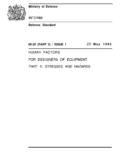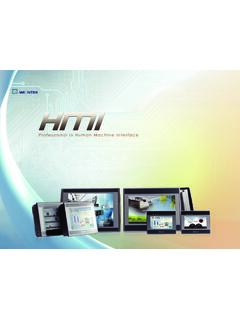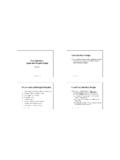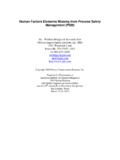Transcription of User Interface Guidelines - Deep Slow Easy
1 user Interface GuidelinesDocument Number UICC-GUIDE-001 November 4, 1988 Jane Lewis (LEWISJ at RCKVM1)Fran Phillips (PHILLIPF at RCKVM1)International Business Machines CorporationSystems Integration DivisionSystem Technology and ProductsUser Interface Center of Competence18100 Frederick PikeGaithersburg, MD20879 IBM Internal Use OnlyIBM Internal Use OnlyiiUI GuidelinesIBM Internal Use OnlyUICC-GUIDE-001 November 4, 1988 PrefaceThis document provides Guidelines for design and development of the user Interface (UI), often referred toas the Human-Computer Interface . It is intended for both management and technical personnel who areresponsible for a project s software user data into a system to schedule satellite contacts, touching a screen to select the WITHDRAWCASH option on an automatic teller machine, or using a joystick to play a video game are all examples of peopleinterfacing with a computer.
2 Different UI design elements must be employed to support each of their needs,which vary because of the nature of the tasks they are performing, and because of their own experience,expertise and personal UI Guidelines define a user Interface implementation methodology applicable to any system s develop-ment life methodology identifies and describes the critical UI development activities which resultin an Interface that successfully meets both user needs and system methodology does notrequire the development of any new documents; all UI documentation is integrated into established Guidelines are presented in the context of a phased process which can be implementedon diverse application development Internal Use OnlyivUI GuidelinesIBM Internal Use OnlyUICC-GUIDE-001 November 4, 1988 ContentsPart 1.
3 Introduction ..1UI Guidelines 1 user Interface (UI) 2UI Development 2 Management ..2 Requirements Analysis and Definition .. 3 Design and 3 Test ..4UI Guidelines Relationship to Human-Computer Interface Requirements Specification (HCIRS)Bulletin ..4 Phased UI Development 8UI Activities 14 Part 2. UI Development 1. UIPreproposal/Proposal ..21 Goals ..21 Tasks ..21 Products ..22 Related Project 22 Additional Information Sources .. 22 Issues To Be 22 Risks/Concerns ..24UI Resource Requirements 24UI Configuration 24 user Documentation 24 user Reviews/Participation.
4 24UI Preproposal/Proposal 27 Management ..27 Requirements Analysis and 29 Design and 31UI Design Team Rationale, Composition & 33UI Design Team Rationale and 33UI Design Team Composition .. 33 Discipline Responsibilities ..34 Systems Engineering (SE).. 34 Software Engineering (SWE).. 34 Hardware Engineering (HWE).. 34 Human Factors Engineering (HFE).. 34 Integration and Test (I&T).. 34 Integrated Logistics Support (ILS).. 34QA ..35 user ..35 Usability ..37 Usability Plan ..37 Usability Objectives ..37 Usability Evaluation/Measurement 37 ContentsvIBM Internal Use OnlySchedule.
5 39 Risks ..39 Key Dependencies ..39 Relationship Between Usability Objectives and UI 44 Usability Objectives ..44 System UI 44 Software UI 44 Usability Checklist ..46 Phase 1 48 Phase 2. UI Concept 51 Goals ..51 Tasks ..51 Products ..52 Related Project 52 Additional Information Sources .. 52 Issues To Be 53 Risks/Concerns ..54 Concept Development 55 Management ..55 Requirements Analysis and 55 Design and 57 user Profile 59 user Profile Tool 64 HCIRSB ulletin ..69 MitreGuidelines ..70 SAA/CUA ..71 Dialog Style Trade-offs .. 72 user Documentation and Training Development.
6 74UI Life Cycle Phase 1 (Pre-proposal/Proposal).. 74UI Life Cycle Phase 2 (Concept Development) and Phase 3 (Requirements Analysis and Definition) 74UI Life Cycle Phase 4 (Evaluation).. 75UI Life Cycle Phase 5 (Operations Support) .. 75UI Life Cycle Phase 6 (Post-Installation).. 76 Usability Checklist for user 78 Online HELP 79 ComputerMessages ..81 Computer Message 82 Phase 2 83 Phase 3. UI Requirements Definition and 85 Goals ..85 Tasks ..85 Products ..86 Related Project 86 Additional Information Sources .. 86 Issues To Be 87 Risks/Concerns.
7 89 Maintaining user 89 Continued Usability 89 Incorporating Usability in UI 89 Maintaining UI Product 90UI Requirements Definition & Design 91 Management ..91 Requirements Analysis and 91viUI GuidelinesIBM Internal Use OnlyUICC-GUIDE-001 November 4, 1988 Design and 92 Test ..93 Phase 3 94 Phase 4. UIEvaluation ..97 Goals ..97 Tasks ..97 Products ..97 Related Project 98 Additional Information Sources .. 98 Issues To Be 98 Risks/Concerns ..99UI Evaluation 101 Management ..101 Design and 101 Test ..102 Sample user Evaluation 103 Phase 4 109 Phase 5.
8 UI Operations 111 Goals ..111 Tasks ..111 Products ..111 Related Project Information Sources .. 112 Issues To Be 112 Risks/Concerns ..113UI Operations Support 115 Management ..115 Requirements Analysis and 115 Design and 115 Test ..116 Phase 5 117 Phase 6. UI Post-Installation ..119 Goals ..119 Tasks ..119 Products ..119 Related Project Information Sources .. 119 Issues To Be 120 Risks/Concerns ..120UI Post-Installation 121 Management ..121 Test ..122 Phase 6 123 Glossary ..Glossry-1 Bibliography ..Biblio-1 ContentsviiIBM Internal Use OnlyviiiUI GuidelinesIBM Internal Use OnlyUICC-GUIDE-001 November 4, 1988 Figures 1.
9 UserInterface ActivitiesDuring Project Development ..5 2. Typical UIActivitiesTimeline ..7 3. UserInterface ActivitiesDuring Phase 1 ..20 4. Cost of Change Over the UILife Cycle ..32 5. UI Responsibilities and Interfaces by Discipline ..36 6. Sample Usability Plan Outline ..40 7. Sample Usability Plan Schedule (Interdependencies notshown) ..43 8. UserInterface ActivitiesDuring Phase 2 ..49 9. UserDocumentation and Training Development .. Interface Activities During Phase Interface Activities During Phase Interface Activities During Phase Interface Activities During Phase 118 FiguresixIBM Internal Use OnlyxUI GuidelinesIBM Internal Use OnlyUICC-GUIDE-001 November 4, 1988 Tables 1.
10 Overview of UI Goals, Tasks, andProducts by Phase ..8 2. Discipline Responsibilities for UIActivities ..15 3. Usability Objectives and UIRequirements Examples ..45 4. DialogStyle Trade-offs ..72 TablesxiIBM Internal Use OnlyxiiUI GuidelinesIBM Internal Use OnlyPart user Interface (UI) Guidelines identify, define and describe a process for designing and validating thesoftware user Interface during a system s development and deployment. The UI development process con-sists of six phases; each phase corresponds to a section in these the UI process hasbeen divided into distinct phases, it is important to understand that the development process is design may undergo modifications as it is refined during each phase of the Guidelines OrganizationThis document contains the following sections.






